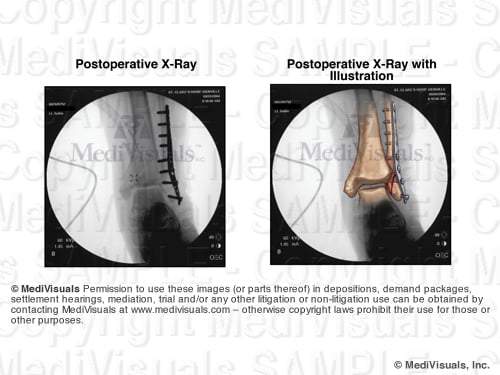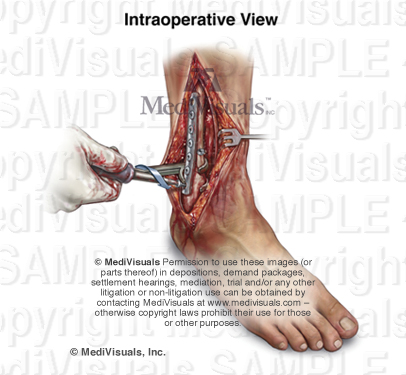By: Robert Shepherd MS, Certified Medical Illustrator, Vice President and Director of Eastern Region Operations, MediVisuals Incorporated
The surgical trauma that a plaintiff has to undergo after the initial bodily injuries following a traumatic event are always major points of emphasis when arguing damages in a personal injury case. This is certainly the situation with cases that involve broken bones that require invasive surgical procedures to realign broken bone fragments ("reduce") and secure ("fixate") the bones with hardware to keep them properly aligned during healing. Too often, however, the emphasis is solely on the effects on the bones from these "Open Reduction and Internal Fixation" (ORIF) procedures, and very little emphasis is placed on the surgical disruption of the soft tissues that takes place during these procedures.
In a case involving ORIF of a distal fibula (a.k.a. lateral malleolus) fracture, in order to emphasize the surgical trauma endured by a plaintiff, an attorney may have a visual prepared of a postoperative X-ray. The visual may consist of only a postoperative X-ray or a print of the X-ray with a corresponding illustration (see the below figure).

The above images are certainly helpful, but fail to address the intra-operative trauma to the soft tissues that is required to gain access to the bone fragments. For that purpose, intra-operative illustrations that truthfully depict the soft tissue disruption should be considered (see the below figure) or even an animation showing the procedures such as the one at this link: http://www.medivisuals.com/fibularplatingORIF.aspx
Illustrations or animations that at least touch on the soft tissue disruption allow testifying physicians the opportunity to explain the many tissues traumatized during the procedure and allow insurance adjustors, mediators, and jurors an opportunity to take these additional injuries into consideration when determining the severity of a plaintiff's entire injuries.

Many attorneys considering realistic illustrations such as the one above, express a concern that judges may not allow the images to be used because they are too "graphic" or "inflammatory". Certainly, counsel should make themselves aware and consider the preferences of certain jurisdictions and specific judges before determining whether an illustration should be developed that realistically depicts injuries or whether diagrammatic (cartoon-like) illustrations should be developed instead. There are a number of very good arguments to support the use of "realistic" illustrations over "cartoons". Those arguments as well as other discussions regarding illustration styles will be addressed in future blogs.










